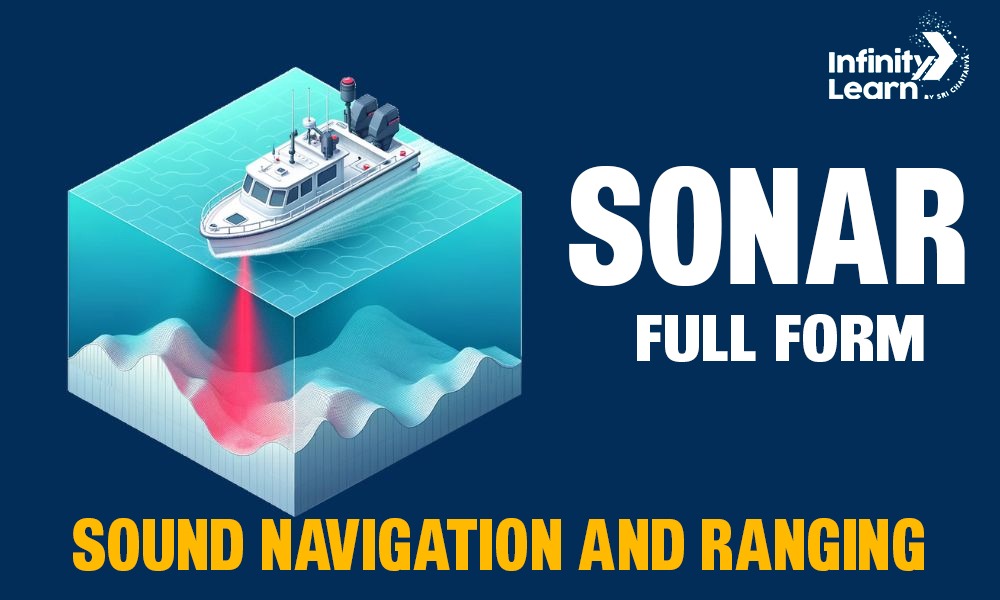Table of Contents
SONAR Full Form is Sound Navigation and Ranging. SONAR is a technology that uses sound waves to find and track objects, mainly beneath the water’s surface. SONAR is often used in submarines, ships, and underwater research to measure distance, find other vessels, or help with navigation. It’s like a RADAR, but instead of radio waves, it uses sound.
SONAR, which stands for Sound Navigation and Ranging, is a technology used to detect and locate objects underwater using sound waves. The idea behind SONAR was first explored by Leonardo da Vinci in 1490, and later developed into a working system after the Titanic disaster in 1912, to help detect icebergs. Reginald Fessenden is credited with inventing the first working SONAR device.
SONAR works by sending sound waves underwater and listening for the echoes that bounce back, helping to measure distance, find objects, and map the ocean floor. It is widely used by ships, submarines, and scientists for navigation, underwater communication, and studying marine environments. Animals like whales and dolphins also use similar natural sound techniques called echolocation.

What is the Full Form of SONAR?
SONAR Full Form stands for Sound Navigation and Ranging. It uses sound waves to find, track, and measure objects under the water. Ships and submarines mostly use SONAR to navigate safely, detect other vessels, and explore the ocean. SONAR works by sending sound pulses into the water and listening for the echoes that bounce back. This helps in finding the position, size, and shape of underwater objects. It is widely used in ships, submarines, and by scientists to map the ocean floor, detect obstacles, and study marine life.
Because sound travels faster and farther in water than light or radio waves, SONAR is more effective for underwater exploration. The technology also plays a key role in navigation, underwater communication, and ocean research. Scientists and engineers improved SONAR in the 1930s, making it a key tool for both military and scientific use.
SONAR Full Form Pronunciation
The pronunciation of SONAR is:
/ˈsoʊ.nɑːr/
It is pronounced as “SO-nar,” where “SO” sounds like “so” in “solar” and “nar” rhymes with “car.”
Who Invented SONAR (Sound Navigation and Ranging)?
Reginald Aubrey Fessenden, a Canadian-American inventor and electrical engineer, is credited with the invention of the early form of SONAR. He developed this technology in the early 1900s to help detect underwater objects using sound waves. Fessenden made major contributions to both radio communication and underwater detection systems.
His invention paved the way for modern SONAR, now widely used in submarines, ships, and ocean research. Along with SONAR, he also pioneered key advancements in radio technology, especially amplitude modulation (AM), which greatly improved long-distance voice communication.
History of SONAR (Sound Navigation and Ranging)
SONAR is a powerful underwater detection system that uses sound waves to find and track objects beneath the water. The concept of using sound for navigation and detection has existed for a long time, with both nature and humans exploring its potential. Here’s a simple look at how SONAR technology developed over time:
Key Milestones in the History of SONAR
- Early Observation (1490): Leonardo da Vinci was one of the first to explore underwater sound. He used a simple tube placed in water to listen for ships, marking the earliest known human use of underwater sound detection.
- Underwater Bells (Late 1800s): In the late 19th century, underwater bells were used near lighthouses and ships to warn of nearby hazards using sound.
- Titanic Disaster (1912): The tragic sinking of the Titanic inspired scientists to develop better underwater detection tools to locate icebergs and avoid future accidents.
- First Patents (1912–1913): Lewis Fry Richardson in England and Alexander Behm in Germany filed the first patents for underwater echo-ranging devices shortly after the Titanic incident.
- Fessenden Oscillator (1914): Reginald Fessenden, a Canadian engineer, created an early SONAR system. He tested it at sea and successfully detected an iceberg from 2 miles away using sound waves.
- World War I Advances (1915): During World War I, the need to detect submarines led to rapid progress.
- Over time, improved materials like piezoelectric crystals, magnetostrictive devices, and plastic film hydrophones helped make SONAR more accurate and efficient.
From a simple tube in the water to advanced sonar systems in ships and submarines, the history of SONAR shows how technology has evolved to make the underwater world safer and more understandable.
Functions of SONAR
- Object Detection and Location- SONAR can find submarines, ships, underwater obstacles, and marine life by sending out sound pulses and listening for echoes. This helps vessels avoid collisions and identify potential threats.
- Distance Measurement (Ranging) – By calculating the time between sending a sound pulse and receiving its echo, SONAR determines exact distances to underwater objects. This is crucial for safe navigation.
- Underwater Navigation – Ships and submarines use SONAR to navigate safely through unfamiliar waters, especially in poor visibility conditions like fog or darkness.
- Communication – Underwater vehicles can use SONAR signals to communicate with each other when radio waves cannot penetrate water effectively.
- Target Classification – Advanced SONAR systems can identify what type of object they’ve detected by analyzing the pattern and strength of returning echoes.
Types of SONAR Systems
Their are mainly two types of SONAR Systems – Active SONAR that sends out sound waves and listens for the echoes that bounce back from objects to detect their location and distance.
Passive SONAR only listens to sounds made by other objects, like ships or submarines, without sending out any sound waves.
Active SONAR
- Active SONAR sends sound waves (called pings) into the water and listens for the echoes.
- It gives accurate range and direction details.
- It can detect quiet or hidden objects underwater.
- However, it reveals the user’s location to enemies.
- It may disturb marine animals and is affected by underwater noise.
Passive SONAR
- Passive SONAR only listens to sounds made by other objects in the water.
- It uses hydrophones to detect and analyze sound patterns from ships or marine life.
- Passive SONAR operates silently and cannot be detected by others.
- It works well for stealth missions and often has a longer range.
- Passive SONAR cannot measure exact distances and needs the target to make noise.
- Background ocean noise can affect its accuracy.
Applications of SONAR Systems
- It helps locate underwater mines to prevent ship damage.
- Modern torpedoes use SONAR to guide them to targets.
- Ports use SONAR to monitor for divers or suspicious underwater vehicles.
- Fishermen use SONAR to find fish, check fish density, and avoid obstacles.
- Shipping vessels use SONAR for safe navigation and depth measurement.
- Scientists use SONAR to study marine life, migration, and ecosystem health.
- Oceanographers map the seafloor and explore deep-sea features.
- Climate researchers use SONAR to study water layers, currents, and ice thickness.
- Search teams use SONAR to find sunken ships, crashed planes, and lost cargo.
- Rescue operations use it to plan underwater recovery and ensure diver safety.
- Environmental teams use SONAR to detect oil spills and underwater pollution.
- Engineers use it to inspect bridges, dams, ports, and underwater cables.
What are the Limitations of SONAR?
- Salt levels and pressure changes affect sound speed and accuracy.
- Rough weather and waves interfere with SONAR signals.
- Ship traffic and marine life noises can cause interference.
- Sound weakens over long distances and limits range.
- High-frequency SONAR has short range but good detail.
- Low-frequency SONAR travels far but gives less detail.
- SONAR may struggle to separate objects that are very close.
- It may miss small or oddly shaped targets.
- Sound travels slowly in water, causing delays in fast-moving detection.
- Quiet or stealth objects are hard to detect.
- Marine life, rocks, or equipment errors may cause false alarms.
- Loud SONAR can harm whales, dolphins, and fish.
- It can disturb marine behavior, breeding, and communication.
- Active SONAR use can expose military locations to enemies.
- Enemy countermeasures and electronic attacks can weaken SONAR.
- Advanced SONAR systems are expensive and need expert operators.
- Sound waves cannot pass through solid barriers fully.
- Low frequencies have range but lack detail; high ones have detail but less range.
SONAR Full Form in Physics
In physics, the full form of SONAR is Sound Navigation and Ranging.
SONAR works by sending sound waves underwater and listening for the echo that bounces back. This helps in detecting, tracking, and measuring the distance of objects below the surface. The system relies on the reflection of sound to identify what’s around, making it useful in areas like submarine movement, ocean research, and underwater mapping.
SONAR Full Form in Hindi
SONAR का पूरा नाम है साउंड नेविगेशन एंड रेंजिंग।
यह एक तकनीक है जो पानी के नीचे वस्तुओं का पता लगाने, उनकी दूरी मापने और स्थिति जानने के लिए ध्वनि तरंगों का उपयोग करती है। इसका इस्तेमाल नौसेना, मत्स्य पालन, समुद्र विज्ञान और जल सर्वेक्षण में किया जाता है।
SONAR Full Form in Tamil
SONAR என்றால் ஒலி வழிசெலுத்தல் மற்றும் அளவீடு (Oli vazhiseluththal matrum alaveedu).
இது கடலுக்கடியில் பொருட்களை கண்டறியவும், அவற்றின் தூரம் மற்றும் நிலையை அறியவும் ஒலி அலைகளை பயன்படுத்தும் ஒரு நவீன தொழில்நுட்பம் ஆகும்.
SONAR Full Form in Kannada
SONAR ಅಂದರೆ ಧ್ವನಿ ನಾವಿಗೇಶನ್ ಮತ್ತು ಅಳೆಯುವಿಕೆ (Dhvani Navigation mattu Aleyuvike).
ಇದು ಸಮುದ್ರದ ಒಳಗೆ ವಸ್ತುಗಳನ್ನು ಪತ್ತೆಹಚ್ಚಲು ಮತ್ತು ಅವುಗಳ ದೂರವನ್ನು ಅಳೆಯಲು ಧ್ವನಿ ತರಂಗಗಳನ್ನು ಬಳಸುವ ತಂತ್ರಜ್ಞಾನವಾಗಿದೆ.
SONAR Full Form in Gujarati
SONAR નો સંપૂર્ણ અર્થ છે સાઉન્ડ નેવિગેશન એન્ડ રેન્જિંગ।
આ એવી ટેક્નોલોજી છે જે પાણીની અંદર અવાજની તરંગો દ્વારા વસ્તુઓ શોધવા, દૂરી માપવા અને સ્થળ નિર્ધારણ માટે વપરાય છે.
Conclusion
SONAR has transformed underwater navigation, defense, and ocean research. It is used for detecting submarines, guiding ships, studying marine life, and more. Despite some limitations, it remains essential in exploring and protecting our oceans.
SONAR Full Form FAQs
What is SONAR used for?
SONAR, short for Sound Navigation and Ranging, helps detect and track objects beneath the water. People use it in submarines for navigation, in marine science to study sea life and the ocean floor, in fishing to find schools of fish, and in underwater communication systems.
Write the Full Forms of SONAR and RADAR?
SONAR stands for Sound Navigation and Ranging. It uses sound waves underwater to find the position and distance of objects. RADAR means Radio Detection and Ranging. It uses radio waves through the air to detect objects like aircraft, ships, or weather patterns.
What is the working principle of SONAR?
SONAR works on the echo-ranging principle. It sends sound pulses (pings) underwater, which bounce back when they hit an object. The echo is received and analyzed to determine the distance, direction, and size of the object.
What is the full form of SONAR in Class 9th science?
In Class 9 science, SONAR stands for Sound Navigation and Ranging. It is explained as a technology that uses sound waves to detect objects underwater and is often studied in topics like wave behavior, reflection, and applications of sound.
Who discovered SONAR?
Reginald Aubrey Fessenden, a Canadian-American engineer, is credited with developing the first working SONAR system in 1914. His invention could detect icebergs and submarines using reflected sound waves.
What waves are used in SONAR?
SONAR uses sound waves, specifically ultrasonic waves, which are sound waves with frequencies higher than 20,000 Hz. These waves travel well through water and are ideal for underwater detection.
When and why was the first SONAR-type listening device invented?
The first SONAR-type device was invented shortly after the Titanic disaster in 1912, to detect icebergs and underwater obstacles. It was developed to improve maritime safety and help avoid collisions at sea.
How is SONAR used in the military?
In the military, SONAR is used for submarine detection, torpedo guidance, mine location, and naval surveillance. It helps navies to track enemy vessels, navigate in deep waters, and secure coastlines during operations.
How is SONAR used in marine biology?
Marine biologists use SONAR to study fish populations, track whale migration, and monitor marine habitats. SONAR helps scientists observe underwater ecosystems, map the ocean floor, and measure changes in marine biodiversity.









